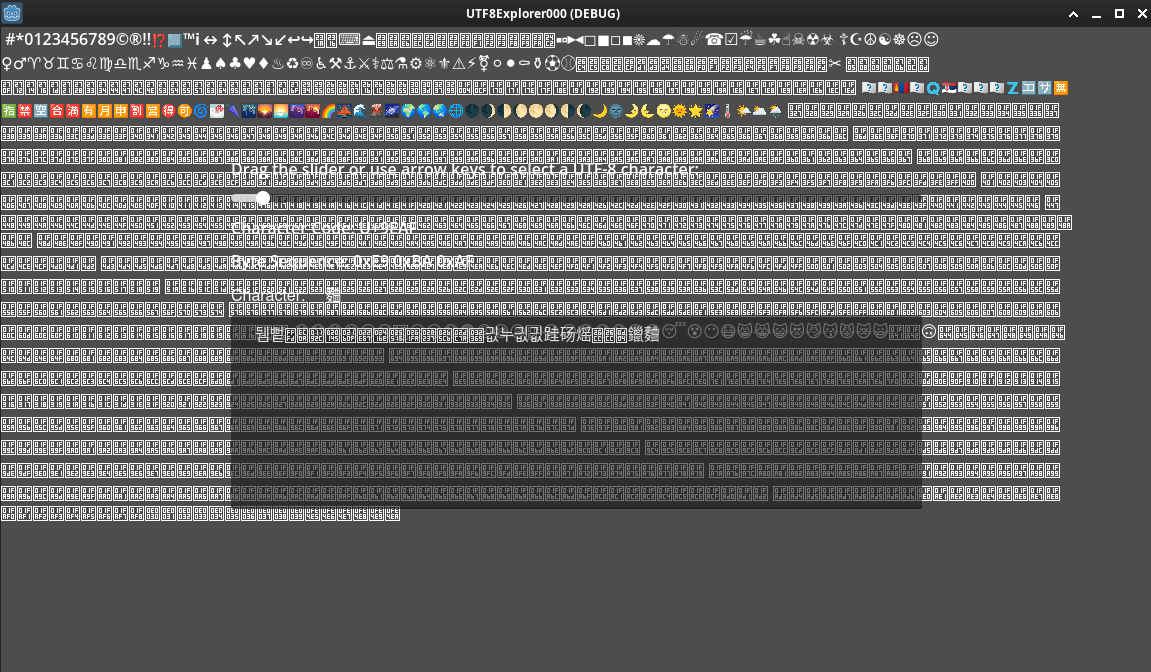Godot Version
3.x
Question
Why is Label trimming more than 3 consecutive' ' spaces? (godot3.6,4.3)
Why can't see emojies in my UTF8-xplorer'? (godot3.6)
Hello there.
Deving a complex ascii art game and been struggling to put the actual contents of some well crafted text files with ASCII art on Label objects. As you might expect from title, ascii art txt files are getting their lovely white spaces removed, and is hard to input certain characters at center locations. I understand this can be desired behavior for most users, but breaks ascii art. If any experienced dev could point me to the Label trimming white spaces code, or an easy way to bypass this would be great. Using a single Label object with the full string from an ascii art .txt file on resources and you will notice above 3 spaces next characters are shifted and breaks art alignment. even using unicode space with no breaks still gets eaten/trimmed.
Also extending support to emojies, so i devved a nice UTF8-xplorer attached here for you to try it out, having a hard time to find the actual ranges for specific emojies (you can use the slider or the arrow keys, i can see some chars and occasionally some emojies, but never the expected emoji map i need to make to make this game happen). I tried the emoji addon which works, but in need of rawer access to emoji gen. Also you need an emoji font, tried a couple already, still not there yet.
Would be great to hear some input, if you can chyme in please do.
See you around ~
&c
→ scene with root control node, emoji font, attach the script and run
extends Control
var utf8_label
var utf8_slider
var utf8_value_label
var utf8_byte_label
var utf8_output_label
var utf8_text_edit
const MARGIN_PERCENT = 0.2
const MIN_CHAR_CODE = 32
const MAX_CHAR_CODE = 0x10FFFF # Full Unicode range
const MAX_TEXT_LENGTH = 1000 # Maximum number of characters in the text field
var emoji_font: DynamicFont = DynamicFont.new()
func _ready():
# Load a font that supports emojis
emoji_font.font_data = load("res://NotoEmoji-Regular.ttf")
if not emoji_font:
print("Warning: Emoji font not loaded. Emojis may not display correctly.")
setup_ui()
utf8_slider.connect("value_changed", self, "_on_slider_value_changed")
utf8_text_edit.connect("text_changed", self, "_on_text_edit_changed")
utf8_slider.min_value = MIN_CHAR_CODE
utf8_slider.max_value = MAX_CHAR_CODE
utf8_slider.step = 1
utf8_slider.value = MIN_CHAR_CODE
func setup_ui():
var viewport_size = get_viewport().size
var margin_size = Vector2(viewport_size.x * MARGIN_PERCENT, viewport_size.y * MARGIN_PERCENT)
# Create and set up the ui's
utf8_label = Label.new()
utf8_label.text = "Drag the slider or use arrow keys to select a UTF-8 character:"
add_child(utf8_label)
utf8_label.set_position(margin_size)
utf8_label.set_size(Vector2(viewport_size.x - 2 * margin_size.x, utf8_label.get_minimum_size().y), false)
utf8_slider = HSlider.new()
add_child(utf8_slider)
utf8_slider.set_size(Vector2(viewport_size.x - 2 * margin_size.x, 0))
utf8_slider.set_position(margin_size + Vector2(0, utf8_label.get_minimum_size().y + 10))
utf8_value_label = Label.new()
add_child(utf8_value_label)
utf8_value_label.set_position(utf8_slider.rect_position + Vector2(0, utf8_slider.get_minimum_size().y + 10))
utf8_value_label.set_size(Vector2(viewport_size.x - 2 * margin_size.x, utf8_value_label.get_minimum_size().y))
utf8_byte_label = Label.new()
add_child(utf8_byte_label)
utf8_byte_label.set_position(utf8_value_label.rect_position + Vector2(0, utf8_value_label.get_minimum_size().y + 10))
utf8_byte_label.set_size(Vector2(viewport_size.x - 2 * margin_size.x, utf8_byte_label.get_minimum_size().y))
utf8_output_label = Label.new()
add_child(utf8_output_label)
utf8_output_label.set_position(utf8_byte_label.rect_position + Vector2(0, utf8_byte_label.get_minimum_size().y + 10))
utf8_output_label.set_size(Vector2(viewport_size.x - 2 * margin_size.x, utf8_output_label.get_minimum_size().y))
# Create and set up the TextEdit for manual entry of UTF-8 characters
utf8_text_edit = TextEdit.new()
add_child(utf8_text_edit)
utf8_text_edit.set_size(Vector2(viewport_size.x - 2 * margin_size.x, viewport_size.y * 0.3))
utf8_text_edit.set_position(utf8_output_label.rect_position + Vector2(0, utf8_output_label.get_minimum_size().y + 10))
# utf8_text_edit.wrap_mode = TextEdit.LINE_WRAPPING_BOUNDARY # Enable word wrap
# Set emoji font if loaded
if emoji_font:
utf8_text_edit.add_font_override("font", emoji_font)
utf8_output_label.add_font_override("font", emoji_font)
func _on_slider_value_changed(value):
update_utf8_display(value)
func _input(event):
if event is InputEventKey and event.pressed:
if event.scancode == KEY_LEFT:
utf8_slider.value -= 1
elif event.scancode == KEY_RIGHT:
utf8_slider.value += 1
func _on_text_edit_changed():
var text = utf8_text_edit.text
# If the text is too long, remove characters from the beginning
if text.length() > MAX_TEXT_LENGTH:
text = text.substr(text.length() - MAX_TEXT_LENGTH)
utf8_text_edit.text = text
# utf8_text_edit.set_caret_line(utf8_text_edit.get_line_count() - 1)
# utf8_text_edit.set_caret_column(utf8_text_edit.get_line(utf8_text_edit.get_line_count() - 1).length())
func update_utf8_display(value):
utf8_value_label.text = "Character Code: U+%X" % value
# Convert the value to UTF-8 bytes
var utf8_bytes = char(value).to_utf8()
# Create a string representation of the byte sequence
var byte_sequence = "Byte Sequence: "
for byte in utf8_bytes:
byte_sequence += "0x%02X " % byte
utf8_byte_label.text = byte_sequence.strip_edges()
# Convert the value to a UTF-8 character
var c = char(value)
utf8_output_label.text = "Character: " + c
utf8_text_edit.insert_text_at_cursor(c)
# new stuff to put in
# Emoji ranges
const EMOJI_RANGES = [
[0x1F300, 0x1F5FF],
[0x1F600, 0x1F64F],
[0x1F680, 0x1F6FF],
[0x2600, 0x26FF],
[0x2700, 0x27BF],
[0x1F900, 0x1F9FF]
]
